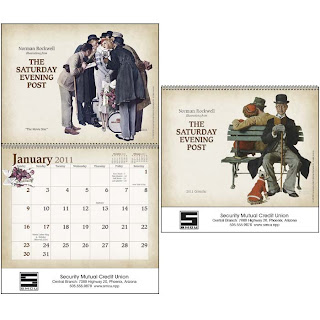>Promotional Gifts of the Season (1) – Calendars
>
This is the first of many articles on the merits of promotions, gifts and advertising this time of the year. Many companies look to reward customers and employees and say thank you and what better way than a personalized gift that will evoke memories for a longer time. My series will focus on products and services that offer choice, variety of price points and different delivery avenues sure to be fit every need.
Calendars. Why are they so popular even in this electronic age? First a brief history lesson*
Calendar advertising has a rich history dating back to the 1850’s when The Ketterlinus Lithographic Manufacturing Co. of Philadelphia began printing calendars that contained advertising. Promotional wall calendars became even more popular as printing technology improved. In 1878, Andrew and Jacob Geiger opened a printing shop in Newark, NJ and began printing advertising calendars, fans, posters and other paper ephemera.
Calendar advertising became increasingly popular in the late 1880’s, thanks to the efforts of two enterprising Ohio newspapermen, Jasper Freemont Meek and his competitor, Henry Beach. They were fierce competitors, and between them, they figured out how to put ads on a myriad of items from aprons, hats and a wide variety of household items. They even invented the classic metal trays advertising colas, which are now prized by antique collectors.
Two more newspapermen, Thomas Murphy and Edward Burke Osborne, both of Red Oak, IA, are credited with inventing art calendars that became immensely popular in the late 1880’s. Like Jasper Meek and Henry Beach, they needed new business to keep their presses busy and bring in additional sales. Osborne printed a watercolor of the new Red Oak courthouse on cardboard, printed advertising around the painting and added a calendar pad. It was a huge success.
Until then, nobody had thought to place attractive art on calendars. The two men purchased fine photographs and paintings from a variety of artists and improved their printing capabilities to include 3-color printing. By 1894, Murphy and Osborne employed a total of 94 people, including 14 traveling salesmen and printed an estimated three million calendars.
At the end of 1894, Murphy sold his interest in the business to Osborne, who moved the company to Newark, NJ to be closer to art and business centers in the New York metropolitan areas. Osborne then seized upon a new printing technology – letterpress printing – to produce calendars of the highest quality. The resulting success of those calendars allowed him to set up printing plants in Toronto, London and Sydney, Australia.
*Special thanks to John J. Robinson – marketing consultant with specialties in print advertising and promotional products.
The benefits of calendars even in our electronic communication society are the same as when they were first introduced — Advertise to a larger audience 365 days a year. When you consider the fact that a good wall calendar is viewed at least once a day the cost per contact is just a few cents. That figure can be even less when you look at the “sphere of influence” factor. How many people come into your office, store, warehouse and home that are also subjected to the ads? Artwork on paper is still a higher perception than a monitor and many people save these photographs.
For the latest in 2011 calendar selection visit our site. Looking for a custom calendar? Just ask as we can design and produce something unique. Call me at 330-963-3664 x 2 for more information.
Look for our next installment of Promotional Gifts of the Season.
Bruce Felber, MAS

Leave a Reply
Want to join the discussion?Feel free to contribute!